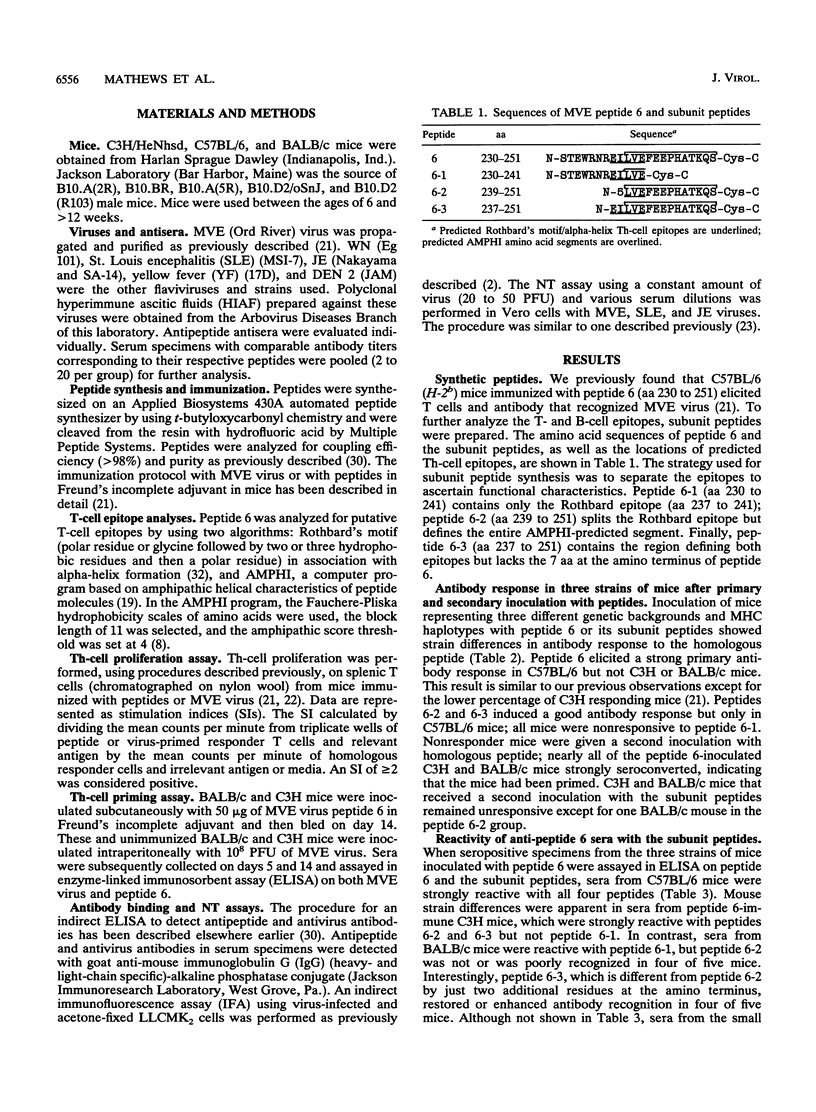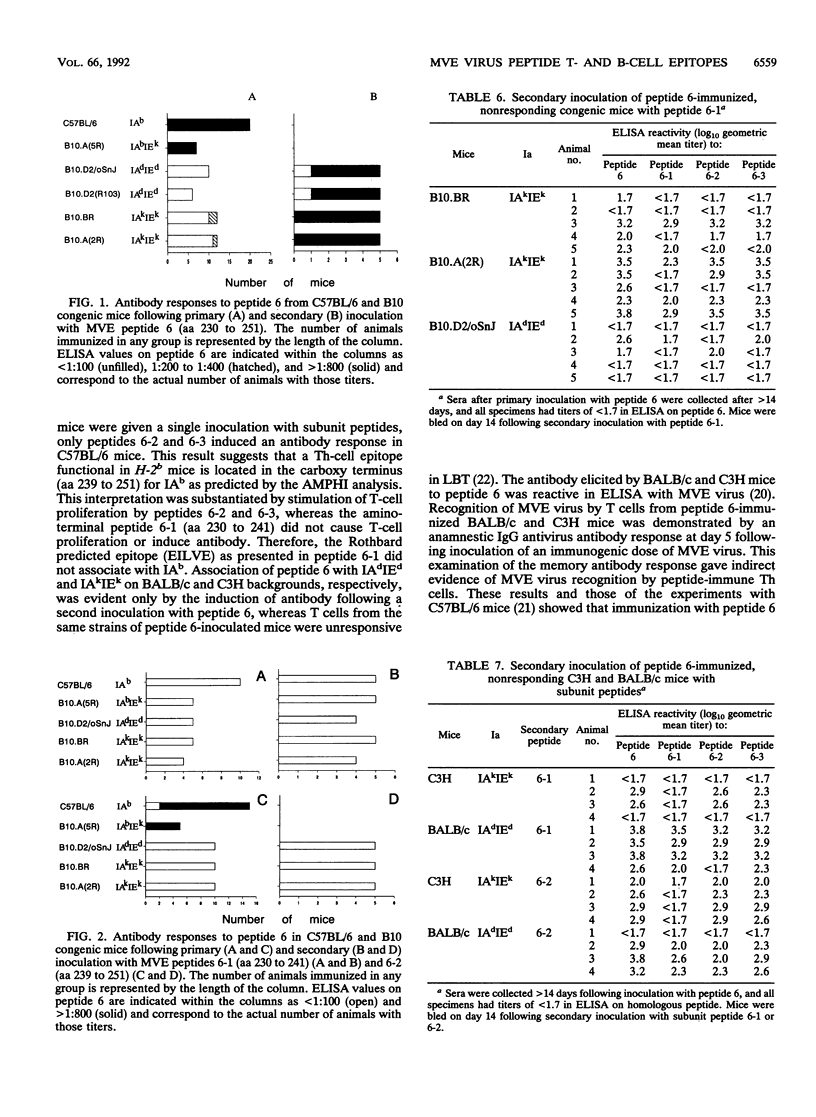Abstract
Synthetic peptides from the envelope glycoprotein sequence of Murray Valley encephalitis (MVE) virus were previously evaluated in various strains of mice for both the induction of antibody and the in vitro proliferation of peptide-primed T-helper (Th) cells. MVE peptide 6 (amino acids 230 to 251) elicited reciprocal Th- and B-cell reactivity with native MVE virus after primary inoculation of C57BL/6 mice. In this study, we prepared overlapping subunit peptides of MVE peptide 6 and evaluated their immunogenicity. Analysis of these peptides delineated at least two B-cell epitopes that induced antibody reactive with MVE and other Japanese encephalitis serocomplex viruses. This antibody at low titer neutralized MVE virus. Genetic restriction of the antibody response to various T-cell elements within peptide 6 was observed in C3H, BALB/c, C57BL/6, and B10 congenic mice. One element demonstrable after primary immunization, located in the carboxy terminus, associated only with major histocompatibility complex class II IAb and IAbiEk glycoproteins. Functional stimulation with the peptides in association with IAkIEk and IAdIEd molecules was observed only after in vivo secondary stimulation. Peptide 6-1 (amino acids 230 to 241) was nonimmunogenic but could be recognized by Th cells from peptide 6-immunized mice. Further association of peptide 6 with the IAkIEk and IAdIEd subregions was demonstrated by the finding that T cells from MVE peptide 6-inoculated C3H and BALB/c mice primed for an antibody response to MVE virus. These results suggest that the peptide 6 sequence, which is relatively conserved among a number of flaviviruses, should be given consideration when synthetic immunogens for vaccine purposes are designed.
Full text
PDF







Selected References
These references are in PubMed. This may not be the complete list of references from this article.
- Barrett A. D., Mathews J. H., Miller B. R., Medlen A. R., Ledger T. N., Roehrig J. T. Identification of monoclonal antibodies that distinguish between 17D-204 and other strains of yellow fever virus. J Gen Virol. 1990 Jan;71(Pt 1):13–18. doi: 10.1099/0022-1317-71-1-13. [DOI] [PubMed] [Google Scholar]
- Brandt W. E. From the World Health Organization. Development of dengue and Japanese encephalitis vaccines. J Infect Dis. 1990 Sep;162(3):577–583. doi: 10.1093/infdis/162.3.577. [DOI] [PubMed] [Google Scholar]
- Celada F., Sercarz E. E. Preferential pairing of T-B specificities in the same antigen: the concept of directional help. Vaccine. 1988 Apr;6(2):94–98. doi: 10.1016/s0264-410x(88)80006-9. [DOI] [PubMed] [Google Scholar]
- Chesnut R. W., Grey H. M. Antigen presenting cells and mechanisms of antigen presentation. Crit Rev Immunol. 1985;5(3):263–316. [PubMed] [Google Scholar]
- Cox J. H., Ivanyi J., Young D. B., Lamb J. R., Syred A. D., Francis M. J. Orientation of epitopes influences the immunogenicity of synthetic peptide dimers. Eur J Immunol. 1988 Dec;18(12):2015–2019. doi: 10.1002/eji.1830181222. [DOI] [PubMed] [Google Scholar]
- Francis M. J., Hastings G. Z., Clarke B. E., Brown A. L., Beddell C. R., Rowlands D. J., Brown F. Neutralizing antibodies to all seven serotypes of foot-and-mouth disease virus elicited by synthetic peptides. Immunology. 1990 Feb;69(2):171–176. [PMC free article] [PubMed] [Google Scholar]
- Gao X. M., Liew F. Y., Tite J. P. A dominant Th epitope in influenza nucleoprotein. Analysis of the fine specificity and functional repertoire of T cells recognizing a single determinant. J Immunol. 1990 Apr 1;144(7):2730–2737. [PubMed] [Google Scholar]
- Halstead S. B., Chow J. S., Marchette N. J. Immunological enhancement of dengue virus replication. Nat New Biol. 1973 May 2;243(122):24–26. [PubMed] [Google Scholar]
- Hart M. K., Palker T. J., Matthews T. J., Langlois A. J., Lerche N. W., Martin M. E., Scearce R. M., McDanal C., Bolognesi D. P., Haynes B. F. Synthetic peptides containing T and B cell epitopes from human immunodeficiency virus envelope gp120 induce anti-HIV proliferative responses and high titers of neutralizing antibodies in rhesus monkeys. J Immunol. 1990 Oct 15;145(8):2677–2685. [PubMed] [Google Scholar]
- Kurane I., Meager A., Ennis F. A. Dengue virus-specific human T cell clones. Serotype crossreactive proliferation, interferon gamma production, and cytotoxic activity. J Exp Med. 1989 Sep 1;170(3):763–775. doi: 10.1084/jem.170.3.763. [DOI] [PMC free article] [PubMed] [Google Scholar]
- Kurata A., Palker T. J., Streilein R. D., Scearce R. M., Haynes B. F., Berzofsky J. A. Immunodominant sites of human T cell lymphotropic virus type 1 envelope protein for murine helper T cells. J Immunol. 1989 Sep 15;143(6):2024–2030. [PubMed] [Google Scholar]
- Kutubuddin M., Kolaskar A. S., Galande S., Gore M. M., Ghosh S. N., Banerjee K. Recognition of helper T cell epitopes in envelope (E) glycoprotein of Japanese encephalitis, west Nile and Dengue viruses. Mol Immunol. 1991 Jan-Feb;28(1-2):149–154. doi: 10.1016/0161-5890(91)90098-5. [DOI] [PubMed] [Google Scholar]
- Liew F. Y., Millott S. M., Schmidt J. A. A repetitive peptide of Leishmania can activate T helper type 2 cells and enhance disease progression. J Exp Med. 1990 Nov 1;172(5):1359–1365. doi: 10.1084/jem.172.5.1359. [DOI] [PMC free article] [PubMed] [Google Scholar]
- Margalit H., Spouge J. L., Cornette J. L., Cease K. B., Delisi C., Berzofsky J. A. Prediction of immunodominant helper T cell antigenic sites from the primary sequence. J Immunol. 1987 Apr 1;138(7):2213–2229. [PubMed] [Google Scholar]
- Mathews J. H., Allan J. E., Roehrig J. T., Brubaker J. R., Uren M. F., Hunt A. R. T-helper cell and associated antibody response to synthetic peptides of the E glycoprotein of Murray Valley encephalitis virus. J Virol. 1991 Oct;65(10):5141–5148. doi: 10.1128/jvi.65.10.5141-5148.1991. [DOI] [PMC free article] [PubMed] [Google Scholar]
- Mathews J. H., Roehrig J. T. Specificity of the murine T helper cell immune response to various alphaviruses. J Gen Virol. 1989 Nov;70(Pt 11):2877–2886. doi: 10.1099/0022-1317-70-11-2877. [DOI] [PubMed] [Google Scholar]
- Mathews J. H., Roehrig J. T., Trent D. W. Role of complement and the Fc portion of immunoglobulin G in immunity to Venezuelan equine encephalomyelitis virus infection with glycoprotein-specific monoclonal antibodies. J Virol. 1985 Sep;55(3):594–600. doi: 10.1128/jvi.55.3.594-600.1985. [DOI] [PMC free article] [PubMed] [Google Scholar]
- Milich D. R., Jones J. E., McLachlan A., Bitter G., Moriarty A., Hughes J. L. Importance of subtype in the immune response to the pre-S(2) region of the hepatitis B surface antigen. II. Synthetic Pre-S(2) immunogen. J Immunol. 1990 May 1;144(9):3544–3551. [PubMed] [Google Scholar]
- Milich D. R., McLachlan A., Moriarty A., Thornton G. B. A single 10-residue pre-S(1) peptide can prime T cell help for antibody production to multiple epitopes within the pre-S(1), pre-S(2), and S regions of HBsAg. J Immunol. 1987 Jun 15;138(12):4457–4465. [PubMed] [Google Scholar]
- Milich D. R., McLachlan A., Thornton G. B., Hughes J. L. Antibody production to the nucleocapsid and envelope of the hepatitis B virus primed by a single synthetic T cell site. Nature. 1987 Oct 8;329(6139):547–549. doi: 10.1038/329547a0. [DOI] [PubMed] [Google Scholar]
- Mosmann T. R., Cherwinski H., Bond M. W., Giedlin M. A., Coffman R. L. Two types of murine helper T cell clone. I. Definition according to profiles of lymphokine activities and secreted proteins. J Immunol. 1986 Apr 1;136(7):2348–2357. [PubMed] [Google Scholar]
- Roehrig J. T., Hunt A. R., Johnson A. J., Hawkes R. A. Synthetic peptides derived from the deduced amino acid sequence of the E-glycoprotein of Murray Valley encephalitis virus elicit antiviral antibody. Virology. 1989 Jul;171(1):49–60. doi: 10.1016/0042-6822(89)90509-6. [DOI] [PubMed] [Google Scholar]
- Roehrig J. T., Johnson A. J., Hunt A. R., Bolin R. A., Chu M. C. Antibodies to dengue 2 virus E-glycoprotein synthetic peptides identify antigenic conformation. Virology. 1990 Aug;177(2):668–675. doi: 10.1016/0042-6822(90)90532-v. [DOI] [PubMed] [Google Scholar]
- Scott P., Natovitz P., Coffman R. L., Pearce E., Sher A. Immunoregulation of cutaneous leishmaniasis. T cell lines that transfer protective immunity or exacerbation belong to different T helper subsets and respond to distinct parasite antigens. J Exp Med. 1988 Nov 1;168(5):1675–1684. doi: 10.1084/jem.168.5.1675. [DOI] [PMC free article] [PubMed] [Google Scholar]
- Street N. E., Schumacher J. H., Fong T. A., Bass H., Fiorentino D. F., Leverah J. A., Mosmann T. R. Heterogeneity of mouse helper T cells. Evidence from bulk cultures and limiting dilution cloning for precursors of Th1 and Th2 cells. J Immunol. 1990 Mar 1;144(5):1629–1639. [PubMed] [Google Scholar]
- Tada T., Takemori T., Okumura K., Nonaka M., Tokuhisa T. Two distinct types of helper T cells involved in the secondary antibody response: independent and synergistic effects of Ia- and Ia+ helper T cells. J Exp Med. 1978 Feb 1;147(2):446–458. doi: 10.1084/jem.147.2.446. [DOI] [PMC free article] [PubMed] [Google Scholar]
- Unanue E. R. Antigen-presenting function of the macrophage. Annu Rev Immunol. 1984;2:395–428. doi: 10.1146/annurev.iy.02.040184.002143. [DOI] [PubMed] [Google Scholar]
- Vitetta E. S., Fernandez-Botran R., Myers C. D., Sanders V. M. Cellular interactions in the humoral immune response. Adv Immunol. 1989;45:1–105. doi: 10.1016/s0065-2776(08)60692-6. [DOI] [PubMed] [Google Scholar]
- van Rooijen N. Antigen processing and presentation in vivo: the microenvironment as a crucial factor. Immunol Today. 1990 Dec;11(12):436–439. doi: 10.1016/0167-5699(90)90171-5. [DOI] [PubMed] [Google Scholar]


